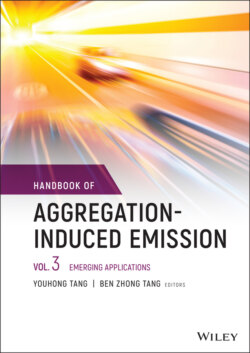Читать книгу Handbook of Aggregation-Induced Emission, Volume 3 - Группа авторов - Страница 52
4.2.1 Metal Transition Complexes
ОглавлениеThe first investigation of AI‐ECL was reported by our group on square‐planar platinum(II) complexes and their supramolecular assemblies in solution and solid‐state (Figure 4.4) [28]. The two complexes presented, 1 and 2 in Figures 4.4a–d, maintain the same tridentate ligand 2,6‐bis(3‐[trifluoromethyl]‐1H‐1,2,4‐triazol‐5‐yl)pyridine (pyC5‐CF3‐tzH2), and differ on the number of triethylene glycols chain attached to a 4‐amino pyridine ancillary ligand. It was demonstrated from the same group that this class of complexes exhibits very poor structured blue emission in a nonpolar solvent like dichloromethane with photoluminescence quantum yield (φPL) around 1% and short lifetimes [52, 53]. When they were dissolved in aqueous media, photoluminescent properties showed a significant bathochromical shift to 600 nm and an enhancement of both φPL and lifetime, up to 70–80%. The group attributed these results to the formation of aggregates in water, which approached single metal complexes from a distance shorter than 3.5 Å. The Pt⋯Pt metallophilic interactions at that distance caused the destabilization of the dz2 orbitals and the population of a new metal‐based highest occupied molecular orbital (HOMO) leading to metal‐metal‐to‐ligand charge transfer (MMLCT) transitions. While 1 formed spherical aggregates not thermodynamically stable in water, complex 2 displayed a stable aqueous suspension of nanoaggregates of 20 nm, which were relatively small to diffuse at the electrode surface and got oxidized. As we said, the Pt⋯Pt interaction destabilizes the HOMO and from an electrochemical point of view it decreases the oxidation potential of complex 2, which was not falling in the electrochemical window of dichloromethane but it is visible at +1.33 V vs Ag/AgCl in water (Figure 4.4e). In fact, upon oxidation and in presence of a coreactant, these nanoaggregates resulted in extremely active ECL compared to the molecularly dissolved complex in dichloromethane or acetonitrile with an ECL efficiency compared to Ru(bpy)32+ of Equation 4.2 using TPrA as coreactant and Equation 1.14 with C2O42−. Despite the impossibility to use complex 1 in solution, it was possible to obtain the same kind of Pt⋯Pt interaction in solid‐state. It is in fact well known that these complexes manifest similar mechanochromical properties [54, 55]. Therefore, it was demonstrated that AI‐ECL emission could be obtained from complex 1 onto screen‐printed electrodes (SPEs) after its blue‐emitting powder was mechanical pressed to generate the desired interaction and therefore an orange solid photoluminescence (PL). The same light could be collected upon electrochemical oxidation in presence of C2O42− obtaining an enhancement of a factor 20 from the blue powder (Figure 4.4c). It is worthful to say that C2O42− acts as a better coreactant because it stabilizes the platinum complex when Pt2+ is oxidized to Pt4+ changing the geometry from square planar to tetrahedral [56]. The change in coordination geometry could be a limitation in the use of these complex‐types for multiple scans and further studies are required to understand deeper mechanism behind the generation of the MMLCT excited state by electrochemistry, since a structural change is happening during the process.
Figure 4.4 (a, d) Chemical structures of the investigated complexes; (b) Photographs of luminescence of Pt‐PEG onto SPE under top‐bench UV lamp (365 nm) and cartoons showing the principle of its mechanocromism before and after grinding with a pestle; (c) ECL emission recorded during a cyclic voltammetry at scan rate 0.2 V/s in 0.1 M LiClO4, aqueous solution of Pt‐PEG physically transferred onto SPE before (blue trace) and after (red trace) mechanical stress using 10 mM Na2C2O4 as coreactant; (e) Cyclic voltammetry at scan rate 0.1 V/s in 0.1 M LiClO4 aqueous solution of 1 (blue trace) and 2 (green trace); (f) ECL intensity during a potential scan of 10−5 M aqueous solution of [Ru(bpy)3]2+ (red trace) and Pt‐PEG2 (blue trace) using 0.1 M LiClO4 as supporting electrolyte upon addition of 10 mM of Na2C2O4. Scan rate 0.05 V/s. GC working electrode, Ag/AgCl reference electrode, and Pt wire counter electrode.
Source: Reproduced from Ref. [28].
This contribution has allowed Ye and coworkers to develop an iriudium(III) complex with AI‐ECL properties[57].) Complex 3 in Figure 4.5a, namely [Ir(tpy)(bbbi)] where tpy is 2,2′ : 6′,2″‐terpyridine and bbbi is 1,3 bis(1H‐benzimidazol‐2‐yl)benzene, contains these two planar and aromatic ligands that can easily generate π–π interactions and that can form hydrogen bonds. Therefore, as for complexes 1 and 2 (Figure 4.4), the self‐assembly of complex 3 in an aqueous solution could form nanoaggregates of 120–160 nm, according to the ratio of water/DMSO (Figure 4.5b). PL was centered at 643 nm and the φPL increased according to the amount of water in the mixture with DMSO. The formation of aggregates was also elucidated by 1H NMR spectra. ECL emission arose cycling at +1.23 V vs Ag/AgCl using TPrA as coreactant. Since the oxidation potential of the latter was at +1.3 V vs Ag/AgCl, we hypothesized that the mechanism follows the “catalytic route” as described by Miao and Bard for metal complexes with lower oxidation potential (Figure 4.5) [29, 58].
Figure 4.5 (a) Chemical structure of complex 3; (b)TEM analysis of nanoparticle size of complex 3 in a DMSO/H2O (10/90 v/v) mixture ; (c) Cyclic voltammogram (dark line) and ECL trace (blue line) of complex 1 (c = 200 μM) in a DMSO/H2O (20/80, v/v) mixture containing 1 mM TPrA, 100 mM NaCl, and 10 mM PBS (pH 7.4). Inset: CV curves of a blank solution (excluding 1 and TPA) and complex 1 in the absence of TPrA; (d) ECL intensity changes of complex 1 (c = 200 μM) upon variation of the H2O fraction of a DMSO/H2O mixture. The scan rate was 0.1 V/s.
Source: Reproduced from Ref. [57].
